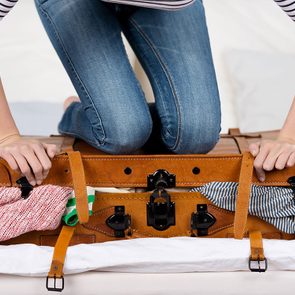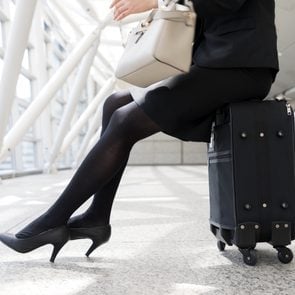I Love My Fat Cat. But When I Moved Cross-Country, I Dreaded Getting Him on a Plane
My husband and I were excited to start a new life in British Columbia. But first we had to figure out how to bring our plus-sized cat with us.

What could go wrong?
I’m an occasional catastrophizer. Facing my first cross-Canada flight with my plus-sized feline, Lance, brought the “cat” part of my condition to the fore.
Planning for the trip involved slightly less preparation than a Sahara trek. My mind pinballed around all the things I couldn’t control, such as the possibility that a 10-year-old, 10.5-kilogram tabby (down from nearly 12 kilograms; don’t judge) would produce a great, noxious poop at 30,000 feet.
Perhaps it would be somewhere over Winnipeg. A planeload of passengers would hate me.
What if Lance launched into his signature premeal wailing or those convulsive, strangled sounds that often serve as the opening act for a dramatic hairball delivery?
The flight was the final step in the decision my partner, Hans, and I made to move from Toronto to Victoria. All the stressful unknowns around this life change, including selling the house, hiring cross-country movers, shipping the car west by train, saying goodbye to friends and the city that had been our home for more than 35 years—all of that was a cakewalk compared to the anxiety I felt about getting a skittish cat onto a plane and keeping him calm during the process. Keeping me calm while trying to do that would be a bonus.
Neither of us would be sedated. The same vet who explained that Lance’s girth stems from being “food motivated” warned us that a zonked-out cat can suffer even more when he’s terrified and immobile.
So we bought a bottle of pheromone spray designed to calm cat nerves. I dosed Lance’s carrier repeatedly and considered spraying it on myself.
I was so twitchy thinking of all that could go wrong with Lance, the move almost took a backseat.
Air Canada charges about $50 to fly your cat or small dog in the cabin on domestic flights, which is a sweet deal. For the aircraft we were taking, the rules state that the pet carrier must measure 21 x 38 x 43 centimetres, weigh less than 10 kilograms and fit under the seat in front of you.
Lance becomes luggage
We were overly optimistic about Lance’s dimensions from the get-go. I ordered an airline-approved carrier online that arrived looking laughably small next to Lance’s sprawl. He’d been on a strict regime of diet cat food for a year, so he wasn’t going to shrink any time soon.
I inspected the underseat area on every flight I took leading up to our move, mentally imagining Lance down there. I worried about how he would handle the experience and quizzed flight crews and other pet-parent passengers.
I decided there was no way Lance would fit under a WestJet seat. Air Canada seats on some flights were roomier.
Carrier-wise, the only thing that would work was something we call Lance’s “little blue house”—a soft-sided pet cage. Using treats (of course) and advised by YouTube videos, I attempted to train him to hang out in the carrier in the hope he’d be happy to travel in it. That was a fleeting dream. But he liked it well enough for naps. If I took two of the three flexible ribs out of little blue house, it could be (mostly) squished under the seat.
Hans would be responsible for carrying Lance onto the aircraft, while trying not to look like the carrier weighed enough to dislocate his shoulder.
I planned to board with a small purse, while the cat would have a wheeled carry-on suitcase lined with an aluminum roasting pan for a makeshift litter tray in case the flight was cancelled or delayed. The interior was jammed with litter, kibble, pee pads, plastic bags, latex gloves and a towel and change of clothes for me in case there was an unfortunate feline incident.
That’s one cool cat
We closed the door on our Toronto house for the last time on a rainy afternoon, sliding the key in the mail slot as I cried sloppy tears fuelled by emotions and stress. Lance quietly meowed a few times in the SUV as we started our drive to the airport. Then he curled up and went to sleep. Let’s hear it for the pheromone spray.
Security at Pearson was the first test. Did I mention that Lance tends to let fly a horizontal stream of urine when he’s nervous?
I had to take him out of his carrier to go through the security scanner. I brought a harness and leash, in case he was tempted to bolt. But if getting Lance into his carrier was often a trial, getting him out in a busy airport would be worse.
“My cat is a projectile pee-er when he’s nervous,” I told the security officer.
He and his colleagues found this hilarious. They led me to a private screening room, where the newly laid-back Lance was easily parted from his carrier.
Lance did not pee. He was quiet. And he went back into his little blue house willingly.
He slept in a corner of the Maple Leaf Lounge while we waited for boarding, occasionally looking out the mesh panels to watch the world. He accepted pettings. He was the same cool cat in the departure area.
Quiet and content, he even purred occasionally during the flight. He didn’t entirely fit under the seat, and many thanks to the flight attendant for failing to mention it. He didn’t care about turbulence, takeoff or whether there were decent in-flight movies. Lance, I discovered, is an absolute champ at air travel. As it turned out, being with us was all he needed. The snoring cat at my feet reminded me it might be a good plan to occasionally let life just unfold.
Eleven hours after locking our Toronto front door for the last time, we walked into our Victoria apartment. I set up a litter box, water and dinner for Lance—and a large glass of British Columbia pinot noir for Hans and myself.
We were home.
© 2019, Linda Barnard. From “How to pack your fat cat as carry-on luggage,” The Globe and Mail (August 6, 2019), theglobeandmail.com.






